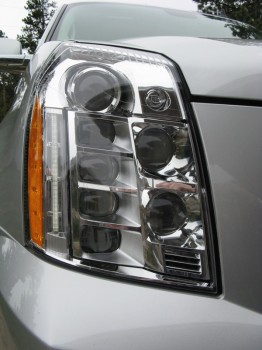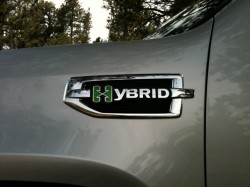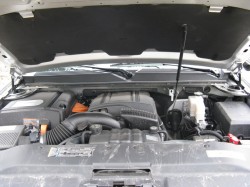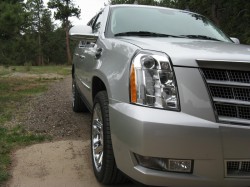2010 Escalade Platinum Hybrid - Design and Technology
Part 1 – OverviewPart 2 – Design and TechnologyPart 3 – Ride and Performance
Image galleries – Escalade Review Pics | Escalade Pics from Cadillac
Before we can fully understand the Escalade, much less the Escalade Hybrid, and where it fits in the Cadillac hierarchy, we need to spend a little time with the history of this truck and to put things into context.
The Escalade is, in many ways, the oldest vehicle in the Cadillac stable - not in the sense of when it was designed and brought to market or even the technology and chassis it is built on. No, the Escalade is the oldest in the sense that it is the latest version of a decade old idea. It is the third generation of, and the spiritual successor to, the original Escalade. As such, it is saddled with the hit it became in pop culture (remember that GM actually focus-grouped this Escalade with professional athletes and A-list Hollywood types prior to its launch). The original Escalade debuted in 1999 as a thinly restyled version of the GMC Yukon Denali. It received more differentiation in its next generation in 2002 and then again in the GMT900-based 3rd generation in 2007. Along, the way, it became the vehicle of choice for a good number of celebrities. It is for that reason alone that it is stuck in a type of market limbo - it can't be altered or re-thought too much without risking its success, even if that success means it ends up somewhat out of touch with the modern Cadillac.
This helps answer why this is the one vehicle in the line that has kept a actual name, though you can see some moves toward the direction of the rest of the brand with Escalade sub-models like the EXT and ESV.
So, after all these years, while we've seen literally every other model in the Cadillac line-up go through massive changes, from shared GM platforms to Cadillac specific (and back again, if you count the new SRX), and a deliberate move to match the German and Japanese competition in many ways - the Escalade is the same basic formula that it started with over a decade ago.
That is not to say, however, that the Escalade is stagnant with regard to technology - especially in the example of our Platinum trim Hybrid test car.
This particular Escalade is packing the same magneto-rheological suspension technology that you see in the most impressive of Cadillacs, like the CTS-V, as well as upper-level Corvettes and also in more than one Ferrari. In this model, it is fighting with a few pounds shy of 3-tons of high-center of gravity mass - so there are no handling miracles like we found in the SRX with its ZF Sachs adaptive setup we drove earlier in the year - but this is more buttoned-down than its Tahoe and Yukon platform-mates as a result.
 Up front, this Escalade has full-LED headlights - putting it in pretty rare company (only Audi's R8 sportscar had them sooner). However, though they are listed as possessing the Intellibeam system that aims the headlights into a turn, I never saw it doing its work like I did in Cadillacs with HID headlights.
Then there is the hybrid part of this long-named truck.
This is the famous 2-mode hybrid system co-developed by GM, Daimler, and BMW. Announced back in 2004 - the technology provides a way to get the benefits of hybrid technology in not only stop and go traffic, but also at highway speeds. This is a marked difference from the traditional hybrid systems in cars like the Prius that provide most, if not all, of their benefit in city settings (which is why you see most hybrids with much higher city than highway numbers on the EPA cycle).
Up front, this Escalade has full-LED headlights - putting it in pretty rare company (only Audi's R8 sportscar had them sooner). However, though they are listed as possessing the Intellibeam system that aims the headlights into a turn, I never saw it doing its work like I did in Cadillacs with HID headlights.
Then there is the hybrid part of this long-named truck.
This is the famous 2-mode hybrid system co-developed by GM, Daimler, and BMW. Announced back in 2004 - the technology provides a way to get the benefits of hybrid technology in not only stop and go traffic, but also at highway speeds. This is a marked difference from the traditional hybrid systems in cars like the Prius that provide most, if not all, of their benefit in city settings (which is why you see most hybrids with much higher city than highway numbers on the EPA cycle).
 The entire hybrid system (with the exception of the battery pack and electronics) is housed within the same housing as a conventional 4-speed Allison automatic - but inside that case lives a pair of electric motor/generators that make all the magic possible. Ultimately, this is a system that provides all the in-town benefits of a hybrid (like Toyota's Synergy Drive or Ford's Hybrid system) while improving economy on the highway and with no loss of truck-like functions like towing capacity (5800 lbs, in case you are wondering).
Read more about the two-mode system over at Wikipedia
While the mileage numbers of the Escalade Hybrid (21 city/22 highway) don't seem, numerically, all that impressive - it is a significant improvement over the same vehicle in non-hybrid form (14/20) - yep 50% improvement in town, and a still impressive 10% highway improvement. We did see a solid 21.5 mpg in mixed and mountain driving during our week behind the wheel.
Doing the math shows that an improvement on a vehicle like this results in a much greater decrease in fuel used and greenhouse gas emissions than say buying a Prius over a Corolla (51/48 vs 26/34)...of course, this assumes you were going to buy the comparable non-hybrid version and are switching to hybrid - since an Escalade buyer likely isn't going to buy a Prius instead. Let's compare:
Assume 15000 miles in a year:
An Escalade would use (16mpg combined) 937.5 gallons
An Escalade hybrid would use (22mpg combined) 681.8 gallons
A Toyota Corolla would use (29mpg combined) 517.2 gallons
A Toyota Prius would use (50mpg combined) 300 gallons
So, buying the hybrid equivalent of the Escalade would save 255.7 gallons. Buying the Prius vs the Corolla would save 217.2 gallons. So, there is something to be said for improving the mileage performance of large, thirsty vehicles. From an environmental point of view, we should be spending some time chasing not ultimate mpg numbers but taking the lowest mileage vehicles and getting some/any improvements we can.
The entire hybrid system (with the exception of the battery pack and electronics) is housed within the same housing as a conventional 4-speed Allison automatic - but inside that case lives a pair of electric motor/generators that make all the magic possible. Ultimately, this is a system that provides all the in-town benefits of a hybrid (like Toyota's Synergy Drive or Ford's Hybrid system) while improving economy on the highway and with no loss of truck-like functions like towing capacity (5800 lbs, in case you are wondering).
Read more about the two-mode system over at Wikipedia
While the mileage numbers of the Escalade Hybrid (21 city/22 highway) don't seem, numerically, all that impressive - it is a significant improvement over the same vehicle in non-hybrid form (14/20) - yep 50% improvement in town, and a still impressive 10% highway improvement. We did see a solid 21.5 mpg in mixed and mountain driving during our week behind the wheel.
Doing the math shows that an improvement on a vehicle like this results in a much greater decrease in fuel used and greenhouse gas emissions than say buying a Prius over a Corolla (51/48 vs 26/34)...of course, this assumes you were going to buy the comparable non-hybrid version and are switching to hybrid - since an Escalade buyer likely isn't going to buy a Prius instead. Let's compare:
Assume 15000 miles in a year:
An Escalade would use (16mpg combined) 937.5 gallons
An Escalade hybrid would use (22mpg combined) 681.8 gallons
A Toyota Corolla would use (29mpg combined) 517.2 gallons
A Toyota Prius would use (50mpg combined) 300 gallons
So, buying the hybrid equivalent of the Escalade would save 255.7 gallons. Buying the Prius vs the Corolla would save 217.2 gallons. So, there is something to be said for improving the mileage performance of large, thirsty vehicles. From an environmental point of view, we should be spending some time chasing not ultimate mpg numbers but taking the lowest mileage vehicles and getting some/any improvements we can.
 One last tech-tidbit that needs discussed in the powertrain...cylinder deactivation (or in Cadillac-speak, active fuel management). This is a technique to run the engine on 4 of it's 8 cylinders (2 in each bank, resulting in a V-4) as often as possible. Given the hybrid system's ability to provide electric boost on the highway, that helps Cadillac tune the engine to cut back to 4-cylinder operation more often. We saw an indicated 10mpg+ boost when this change takes place (there is a DIC mode to show you which mode you are in) - this certainly goes a long way to the 10% overall highway mileage improvement on the window sticker.
Now, let's go to the interior tech tid-bits...
The Platinum trim brings with it just about every goodie that Cadillac could throw the Escalade's way. Including such niceties as:
One last tech-tidbit that needs discussed in the powertrain...cylinder deactivation (or in Cadillac-speak, active fuel management). This is a technique to run the engine on 4 of it's 8 cylinders (2 in each bank, resulting in a V-4) as often as possible. Given the hybrid system's ability to provide electric boost on the highway, that helps Cadillac tune the engine to cut back to 4-cylinder operation more often. We saw an indicated 10mpg+ boost when this change takes place (there is a DIC mode to show you which mode you are in) - this certainly goes a long way to the 10% overall highway mileage improvement on the window sticker.
Now, let's go to the interior tech tid-bits...
The Platinum trim brings with it just about every goodie that Cadillac could throw the Escalade's way. Including such niceties as:
- Bluetooth hands-free for you cell phone
- In-dash navigation with display of power flow in the hybrid system
- Rear-view camera
- 5.1 Surround Sound
- 14-way power heated and cooled front seats
- Heated steering wheel
- Heated and cooled cup-holders
- Power adjustable pedals
- 115V power outlet
- Power rear hatch
- Power assist steps (open the door and steps motor down from the side to give you a graceful way in and out of this high-rider)
- Remote start
- Rear seat entertainment (made up of 2 7" screens integrated into the rear of the front head-rests and a single 8" screen in the headliner in front of the second row seats)
- XM Satellite radio with XM Nav and Traffic data feed
- Sunroof (not the UltraView you get in other Cadillacs, this is a traditional front-row unit)
- StabiTrak stability and traction control
- Blind-spot warning indicators
- Ultrasonic parking assist (rear only)
- Olive Ash and Burled Walnut interior accents
- Aluminum trim accents



The bottom line for all these features? Just over $86000 with destination. I think that warrants at least a subdued 'yikes!'. So, this certainly sounds Cadillac-like, doesn't it? Well, there are a few areas where it is different than the rest of the Cadillacs of recent vintage - both for good and for bad. The good?
- Take your iPod cable, plug it into the center arm-rest USB port, and viola! You have control over practically all functions through the audio system's interface. You'd think this would work everywhere - but Cadillac has a spotty record in our testing with this.
- Need to embarrass your neighbor with the Mercedes GL? Magneto-rheological shocks and full-LED head-lamps are a good start. The ability to putter around town with no gas burned brings it home. Not to mention the smooth good looks and gee-whiz things like the powered running boards.
- Unlike Escalades of old, this one looks much more the part. The crisp fenders and hood, bold grill, as well as front and rear lighting shapes all scream Cadillac. Though it would have been nice if GM could have seen fit to put unique skins on the doors to carry the theme between the front and rear rather than letting the lines fade out just to be picked up again at the other end.
 The bad?
The bad?
- The key fob looks just like the proximity keyless entry and start fobs used by the SRX and CTS. However, the proximity function isn't there. Button push on the fob to unlock and lock as well as key in the ignition to start.
- Generally, the interfaces to navigation, entertainment, and the driver info center are all somewhat non-Cadillac in their graphics and operation. This is likely due to the systems being part of the GMT900 program and specific Cadillac interfaces were likely too much for the development budget.
- Additionally, the feel of many of the buttons, doors, etc. are a little too 'Tahoe' and not quite up to Cadillac feel - reminding us more than once that this was not as much a modern Cadillac interior we've come to expect from the CTS and SRX.
- Missing are some Cadillac staples like the light-pipe accents in the front and rear light clusters as well as the interior accent lighting we've come to expect.
- Call us shallow, but the motor-up nav screen is almost as much an interior signature as the Cadillac badging itself - it isn't needed here because of the sheer amount of space on the dash, but it still is noticable.
So, we find ourselves loving that this Escalade carries its role as Cadillac tech tour de force as only a high-ticket model can. However, we can't help but hope that the next generation model, post GM bankruptcy, will have more resources allocated to it. Therefore, making it a more completely executed Cadillac inside and out, because seeing any sign of its lesser siblings inside is unacceptable in this rarefied segment. But, how does it drive? Let's talk about that in Part 3 - Ride and Performance.
